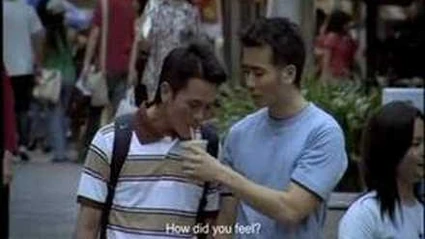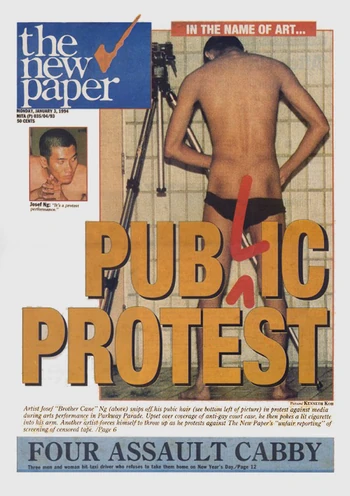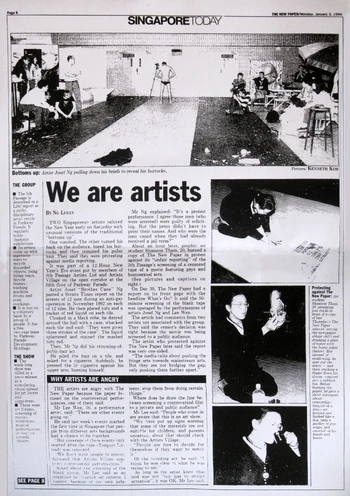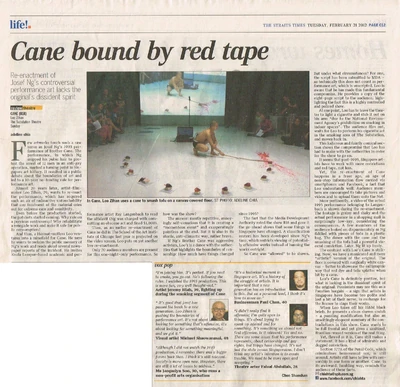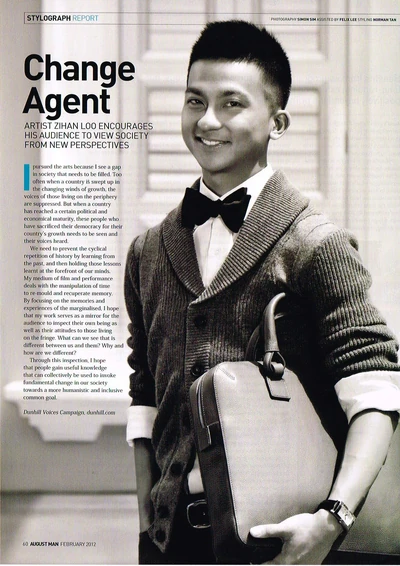On 1 January 1994, Singaporean performance artist Josef Ng protested against the police entrapment, arrest and caning of 12 homosexual men at the reclaimed land and beach off Tanjong Rhu, a popular gay cruising ground (see main article: Fort Road beach: gay aspects). He caned slabs of tofu, turned his back to the audience, pulled down his briefs and snipped off some pubic hair. He was arrested, charged with committing an obscene act and banned from performing in public. His theatre group's grants were also cancelled. The event, entitled Brother Cane, triggered a 10-year restriction on the licensing and funding of performance art in Singapore.
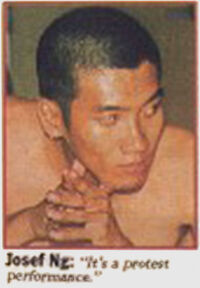
Scan of inset photo of Josef Ng from the front cover of The New Paper, Monday, 31 December 1993.
Background[]
Growth of gay venues[]
The heady days of unmitigated burgeoning of available gay spaces experienced in the 1980's were curbed to some degree in the early 1990's. Singapore's breakneck economic growth was being attributed to Asian values, the most vociferous proponent of whom was Prime Minister Lee Kuan Yew. Family values were seen as an integral subset of these and touted with much verve by the politically commandeered local media. No one took seriously American economic guru, Paul Krugman's assertion that the rapid growth of the Asian Newly Industrialising Economies (NIEs) was mainly due to massive government-directed input factors, much like the Soviet economic expansion of the 1950's, and that this would slow considerably in future without true productivity increases or innovation.
Perceived threat[]
Gays were perceived of as somewhat of a threat to Asian values in some quarters of the establishment and complaints made by members the straight public against rampant cruising led to the implementation of police entrapment in the early 1990s. This occurred both in the back alleys of the city area and at the reclaimed land off Fort Road. Attractive undercover cops would pose as homosexual cruisers and chat up unsuspecting gays in these areas. These decoys would behave suggestively, and the moment they were fondled by their targets, the latter would be arrested for outrage of modesty. Their names and occasionally mugshots were published in the press to humiliate them.
Most prominent case of entrapment[]
- See also: Fort Road beach: gay aspects
William Peterson, in his essay, The Queer Stage in Singapore, a chapter in the seminal book People Like Us: Sexual Minorities in Singapore, detailed one of the most notable instances which "...took place in November 1993, when 12 men were nabbed in an anti-gay operation in Tanjong Rhu, a known gay cruising area. Good-looking, young police officers from the Geylang Police Division Headquarters, locally known as 'pretty police' were used to entrap the men. The names, ages and occupations of the arrested men were reported in the press, along with descriptions of the encounter. According to the Straits Times, in one instance, the accused was said to have "chatted up a special constable, before proceeding to caress his buttocks and chest". Another man who stood accused stated that "the guy [an officer] had approached me and smiled, so I walked over to chit-chat with him." He maintained that the officer then suggested that they go into the undergrowth to have sex. Once physical contact was made, each man was arrested and charged with "outraging their victim's modesty" (The Straits Times, 23 November 1993, page 19). The occupations of the arrested men ranged from butcher to (then) Singapore Broadcasting Corporation producer. Of the 12 arrested, 6 pleaded guilty immediately, receiving sentences ranging from 2 to 6 months in jail. All were given 3 strokes of the rotan or cane, a beating that results in permanent scarring of the buttocks." (see main article: Archive of The Straits Times article, "12 men nabbed in anti-gay operation at Tanjong Rhu", 23 Nov 1993). This episode was immortalised in movie producer Boo Jun Feng's short film, "Tanjong Rhu"[1]:
The gay community was outraged by what they felt was a gross infringement of their right to consensual adult homosexual acts. Heterosexual Singaporeans could continue to have sex in parked cars and in secluded public areas with impunity, whilst homosexuals were being singled out for vilification.
Protest[]
In response to both the entrapment exercise and the sensationalistic treatment of this and other gay-related news stories by the press, two Singaporean artists, Josef Ng (born in Thailand) and Shannon Tham, created performance pieces that the government clearly found threatening to the dominant order. Ng and Tham’s works were presented in the context of a 12-hour New Year’s Eve event which included numerous other performances, literary readings and live music. Early in the morning on Friday, 31 December 1993 at the 5th Passage Gallery which occupied a service corridor in Parkway Parade, a large suburban shopping center dominated by Isetan and Yaohan department stores, Josef Ng gave a performance entitled "Brother Cane", apparently alluding to the caning sentence meted out to the victims of the entrapment operation.
Immediately after it finished the gallery was raided by the police. The spectators, and there were many, dispersed rapidly. The gallery was closed. Ng and his collaborators were arrested. Ng was charged with committing an obscene act which he pleaded guilty to as a course of least resistance. Iris Tan, the gallery manager, was prosecuted for allowing him to do it.
Description of performance[]
Singaporean performance artist and academic, Ray Langenbach, recalled the performance in an affidavit for the defense in the case, Department of the Public Prosecutor versus Josef Ng Sing Chor (1994). The following is a consolidated description from the accounts provided by Ray Langenbach and William Peterson:
Duration 15 minutes: Ng, dressed in a long black robe and black briefs, carefully laid out 12 tiles on the floor in a semi-circle. He placed the news cutting, "12 Men Nabbed in Anti-Gay Operation at Tanking Rhu" from the Straits Times on each tile. He then carefully placed a block of tofu on each tile along with a small plastic bag of red dye.
Duration 1 minute: Ng crouched behind one tile and read random words from the news cutting.
Duration 5 minutes: Ng picked up 3 strips of a child's rotan tied into 1. Striking the floor with it rhythmically, he performed a dance, swaying and leaping from side to side, and finally ending in a low crouching posture.
Duration 3 minutes: Ng approached the tofu blocks, tapping the rotan rhythmically on the floor and performed a dance. He tapped twice next to each block, then whipped each of the 12 bags of red dye and tofu on the third swing. Red paint and soft white tofu splattered violently.
Duration 1 minute: Ng said that he had heard that clipping hair could be a form of silent protest, and walked to the far end of the gallery space. Facing the wall with his back to the audience, he took off his robe, lowered his briefs just below the top of his buttocks and carried out an action that the audience could not see. He returned to the performance space and scatterd a small amount of hair on the center tile.
Duration 1 minute: Ng asked for a cigarette from the audience. He was given one. He lit it. He smoked a few puffs, then, saying "Sometimes silent protest is not enough," he stubbed out the cigarette on his arm. He said "Thank you," and put his robe back on.
Ng's performance was dramatically re-enacted by film producer and performance artist Loo Zihan in Chicago, USA in 2011[2] and again in 2012 in Singapore (see below).
Langenbach suggests that this performance could be seen as an instrument of social healing, drawing on the Southeast Asian ritual tradition of Taoist shamanism. "Ng produced a state of catharsis in the audience—through the per- formance, a social trauma and schism in the community, the transgression, arrest, punishment, and public exposure of the twelve men was ritually remembered and redressed." Drawing together sexuality and ritual, memory and social cohesion, the performance served as a challenge to government policies on both homosexuality and history simultaneously. But Langenbach was not called on to testify.
Tabloid article[]
Scans[]
On Monday, 3 January 1994, the New Paper ran a cover story headlined “Pub(l)ic protest” and the full article entitled, "We are artists" on page 6, portraying the event as an extremely obscene performance[3].
Editable text of article[]
THE NEW PAPER Monday, January 3, 1994
SINGAPORE TODAY
Bottoms up: Artist Josef Ng pulling down his briefs to reveal his buttocks
THE GROUP
■ The 5th Passage is described in a Life! report as a multidisciplinary artist centre in Parkway Parade. It regularly holds thematic exhibitions.
■ Its artists come up with ingenious ways to recycle discarded objects, using fridge trays, bicycle frames, washing machine drums and even stockings.
■ It is run on a voluntary basis by a group of people. It has a free two-year lease by Parkway Parade Development Holdings.
THE SHOW
■ The week-long show was billed in a press release as a stimulating visual spread for art lovers and supporters.
■ There were art forums, screening of movies, workshops, musical performances, interactive comedy theatre
SEE PAGE 8
We are artists
By Ng Li-san
TWO Singaporean artists saluted the New Year early on Saturday with unusual versions of the traditional “bottoms up".
One vomited. The other turned his back on the audience, bared his buttocks and then trimmed his pubic hair. They said they were protesting against media reporting.
It was part of a 12-hour New Year's Eve event put by members of 5th Passage Artists Ltd and Artists Village on the open corridor at the fifth floor of Parkway Parade.
Artist Josef "Brother Cane” Ng pasted a Straits Times report on the arrests of 12 men during an anti-gay operation in November 1992 on each of 12 tiles. He then placed tofu and a packet of red liquid on each tile.
Cloaked in a black robe, he danced around the hall with a cane, whacked each tile and said: "They were given three strokes of the cane". The liquid splattered and stained the mashed tofu red.
Then, Mr Ng did his trimming-of-pubic-hair act.
He piled the hair on a tile, and asked for a cigarette. Suddenly, he pressed the lit cigarette against his upper arm. burning himself.
Mr Ng explained: “It’s a protest performance. I agree those men (who were arrested) were guilty of soliciting. But the press didn’t have to print their names. And why were the men caned when they had already received a jail term?”
About an hour later, graphic art student Shannon Tham, 20, burned a copy of The New Paper in protest against its “unfair reporting" of the 5th Passage's screening of a censored tape of a movie featuring gays and homosexual acts.
(See pictures and captions on right.)
On Dec 30, The New Paper had a report on its front page with the headline What’s On? It said the 50-minute screening of the blank tape was upstaged by the performances of artists Josef Ng and Lee Wen.
The article had comments from two artists not associated with the group. They said the censor’s decision was right because the movie was being screened to a public audience. The artist who protested against The New Paper later said the report was very one-sided. "The media talks about pushing the fringe arts towards mainstream arts. But they are not bridging the gap, only pushing them further apart.”
WHY ARTISTS ARE ANGRY
THE artists are angry with The New Paper because the paper focused on the controversial performances, one of them said.
Mr Lee Wen, 36, a performance artist, said: “There are other events going on."
He said last week's events marked the first time in Singapore that people from different arts backgrounds had a chance to be together.
"But coverage of these events only started after the tape (Tongues Untied was censored. "We don't want people to misunderstand that Artists Village supports controversial performances."
Asked about the screening of the blank movie, Mr Lee said as an organiser he "cannot set criteria. I cannot, because of my own judgment. stop them from doing certain things.”
Where does he draw the line between screening a controversial film to a private and public audience?
Mr Lee said: “People who come in are aware that this is an art show.
“We have put up signs warning that some of the materials are not suitable for children, and parents uncertain about that should check with the Artists Village.
“People are free to decide for themselves if they want to watch it."
Of the vomiting act. he said: "I think he was clear in what he was trying to say."
As long as the artist knew that and was not “out just to attract attention", it was OK, Mr Lee said.
Protesting against The New Paper: Art student Shannon Tham, 20, arranging joss sticks in front of a copy of last Thursday's The New Paper (above), setting the newspaper ablaze (left) and drinking a glass of water with the burnt ashes (below). But instead of swallowing, he spat out the ashes — and then, sticking a tlnger down his throat, vomited into a rubbish bin. Before burning the paper, he gave a short statement about censorship, banned on a drum set. howled and barked like a dog, sang a medley of pop songs, and crawled on his hands and knees.
Subsequent developments[]
Ban on performance art[]
In the following weeks the Singapore government reacted massively and placed a ban on improvisational performing arts which lasted for over a decade[4].
Re-enactment by Loo Zihan[]
Archiving Cane[]
- Main article: Archiving Cane
Archiving Cane was an installation arts project created by Loo Zihan which detailed the timeline of events tracing the history of the present performance remains and documentation from the re-enactments of Josef Ng’s work by Loo ('Brother Cane' and 'Cane') leading up to a durational performance and installation from 7 to 16 December 2012 at The Substation Gallery[5]. The installation was designed in collaboration with TRIPPLE and presented with support from The Substation.
Artists' general assembly - The Langenbach archive[]
Drawing on extensive research and the documentation that survives, Loo Zihan presented a collection of Ray Langenbach's documents regarding Ng's 1993 performance on Thursday, 24 October 2013 at 7pm at Sculpture Square, as part of the exhibition "Ghost: The Body at the Turn of the Century"[6]. The human body, a medium and site of resistance, was employed by artists and reconfigured in unpredictable, seminal moments in the arts and counter-culture. From film, music, photography and performance art, Ghost unearthed a different shape and understanding of Singapore. It was presented in partnership with the Singapore Art Museum and was a collaborative project of the Singapore Biennale 2013 entitled "If the world changed". Ghost ran till 31 December 2013 and opened daily from 11am - 7pm, closed on Mondays.
References[]
- "Archiving Cane", a Facebook page started by Loo Zihan in October 2012 detailing a timeline of events tracing the history of 'Brother Cane' and 'Cane' leading up to a durational performance and installation from 7 to 16 December 2012 at The Substation Gallery:[7]. Additional information on Loozihan.com:[8].
External links[]
- Loo Zihan's website featuring his re-enactment of "Cane" in Chicago, USA. (2011):[9]
- Performance score in PDF format for Loo Zihan's re-enactment of "Cane" on Sunday, 19 February 2012 at 8pm at The Substation in Singapore, which was disseminated to audience members as they entered the performance space:[10].
- Video and photos of Loo Zihan's re-enactment of "Cane" at The Substation, Singapore on 19 February 2012:[11],[12],[13].
- Blog entry by "gdy2shoez" on 18 February 2012 in the blog "Everything also complain":[14].
Acknowledgments[]
This article was written by Roy Tan.
